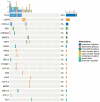MET Exon 14 Skipping Mutations in Lung Cancer: Clinical-Pathological Characteristics and Immune Microenvironment
- PMID: 40710213
- PMCID: PMC12293242
- DOI: 10.3390/curroncol32070403
MET Exon 14 Skipping Mutations in Lung Cancer: Clinical-Pathological Characteristics and Immune Microenvironment
Abstract
MET exon 14 skipping mutations have emerged as significant driver alterations in non-small-cell lung cancer (NSCLC), contributing to tumor progression. This study examines the immune microenvironment in NSCLC patients with these mutations and its prognostic implications. We performed multiplex immunofluorescence (mIF) staining on formalin-fixed paraffin-embedded (FFPE) tissue samples from nine NSCLC patients, including four recurrent/metastatic and five non-recurrent/non-metastatic patients. Two panels assessed immune cell markers (CD8, CD4, CD20, CD68, and FoxP3) and immune checkpoints (PD-L1, LAG3, and TIM3). Immune cell infiltration and checkpoint expression were analyzed using HALOTM software (version 3.6.4134.464). Nearest neighbor analysis was conducted to assess the proximity of immune cells to tumor cells. Univariate Cox regression analysis assessed factors associated with disease-free survival (DFS). CD8+TIM3+ and CD8+LAG3+ cells were predominantly located in the tumor parenchyma of recurrent/metastatic patients but localized to the stroma in non-recurrent/non-metastatic patients. Non-recurrent/non-metastatic patients exhibited a higher density of tertiary lymphoid structures and closer proximity of CD20+ B cells, CD8+TIM3+, and CD8+LAG3+ cells to tumor cells compared to recurrent/metastatic patients, though the differences were not statistically significant. Cox regression analysis suggested a potential association between higher densities of CD8+TIM3+ cells and improved DFS (HR = 0.89), though these findings did not reach statistical significance. Our findings suggest that differences in immune microenvironmental factors, particularly those related to immune checkpoint expression (TIM3 and LAG3), may influence clinical outcomes in NSCLC patients with MET exon 14 skipping mutations. Further studies are needed to validate these observations and explore potential therapeutic implications.
Keywords: MET exon 14 skipping mutation; immune checkpoints; immune microenvironment; multiplex immunofluorescence; non-small-cell lung cancer.
Conflict of interest statement
The authors have no relevant financial or non-financial interests to disclose.
Figures






Similar articles
-
[Joint analysis of invasive margins and tumor center to evaluate the prognostic value of bystander CD8+ T cells in early-stage non-small cell lung cancer].Zhonghua Zhong Liu Za Zhi. 2025 Jun 23;47(6):508-516. doi: 10.3760/cma.j.cn112152-20240805-00326. Zhonghua Zhong Liu Za Zhi. 2025. PMID: 40534266 Chinese.
-
Intratumoral neutrophil-to-lymphocyte ratio is mirrored by circulating neutrophil-to-lymphocyte ratio in non-small cell lung cancer.J Immunother Cancer. 2025 Jun 24;13(6):e011458. doi: 10.1136/jitc-2025-011458. J Immunother Cancer. 2025. PMID: 40555561 Free PMC article.
-
Can a Liquid Biopsy Detect Circulating Tumor DNA With Low-passage Whole-genome Sequencing in Patients With a Sarcoma? A Pilot Evaluation.Clin Orthop Relat Res. 2025 Jan 1;483(1):39-48. doi: 10.1097/CORR.0000000000003161. Epub 2024 Jun 21. Clin Orthop Relat Res. 2025. PMID: 38905450
-
Adjuvant epidermal growth factor receptor (EGFR) tyrosine kinase inhibitors (TKIs) for the treatment of people with resected stage I to III non-small-cell lung cancer and EGFR mutation.Cochrane Database Syst Rev. 2025 May 27;5(5):CD015140. doi: 10.1002/14651858.CD015140.pub2. Cochrane Database Syst Rev. 2025. PMID: 40421698 Review.
-
MET Exon 14 Skipping in NSCLC: A Systematic Literature Review of Epidemiology, Clinical Characteristics, and Outcomes.Clin Lung Cancer. 2023 Sep;24(6):483-497. doi: 10.1016/j.cllc.2023.06.008. Epub 2023 Jun 18. Clin Lung Cancer. 2023. PMID: 37451931
References
-
- Awad M.M., Oxnard G.R., Jackman D.M., Savukoski D.O., Hall D., Shivdasani P., Heng J.C., Dahlberg S.E., Jänne P.A., Verma S., et al. MET Exon 14 Mutations in Non–Small-Cell Lung Cancer Are Associated With Advanced Age and Stage-Dependent MET Genomic Amplification and c-Met Overexpression. J. Clin. Oncol. 2016;34:721–730. doi: 10.1200/JCO.2015.63.4600. - DOI - PubMed
MeSH terms
Substances
Grants and funding
LinkOut - more resources
Full Text Sources
Medical
Research Materials
Miscellaneous

